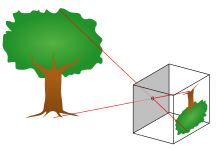I did some research into pinhole photography and looked at these websites:
My favourite pieces came from the first and last site; but I suggest you check them all out because they are different from one another. Where some have pinhole photos or videos submitted by people, others are simply one user pin-holing in their own unique way...
pinholephotography.org work by Justin Quinnell
Camera's recorded views of Bristol with the sun trailing across the sky from the winter solstice (22nd December) to the summer solstice (20th June), this is actually a common use of pin hole photography called solography. JQ is not the only person to have done this there has been Paolo Gioli in Italy and Tanja Trygg in Finland.
Quinnel describes the piece as "...capturing a period of time beyond what we can perceive with our own vision."
I think that this sort of long-term pinhole photography, is particularly interesting in that if any structural changes take place during the time-frame, an outline can usually be made out or clearly seen; similar to that of a 3 minute exposure where the camera has moved. Of course there is the interest in how the sun trails across the sky and leaves a sort of residue trail showing exactly where its been, which is pretty amazing because its obviously there but impossible for the human eye to pick up.
Clifton Suspension Bridge, Bristol, UK.
December 17th 2007 - June 21st 2008
Justin also does a lot of mouthpiece work using his own creation a SmileyCam: a small camera, which can actually fit in your mouth.
 ← SmileyCam
← SmileyCam
For me JQ has shown an individual evolution in photography, you probably could shoot a photo from your mouth just by placing your camera there but I don't think you would be able to deliver a photo quite like his, nor would the camera be so disposable or durable. Also it gives its own style of lighting every time.
 g
________________________________
g
________________________________
pinhole.nl/
On this site all photos have been submitted in particular I looked at people on the site. I found that few managed to remain still enough in the photos to combat blurring, but when I thought about it the blurring seemed to be intentional in some, so as to add an effect to the photo.
Noticeably where the faces are blurred there isn't definition/details however their features remain clear for most.
In other aspects such as lighting and stillness there is much experimentation.
Here are two examples that I liked the most...
This is a staged photo, you can tell by the simple factor of whether there's blurring or not.
- the car is not moving. The outside would be blurred, due to the constant movement during the exposure time
- the drivers hands and body are not blurred suggesting he hasn't moved his hands to steer and stares ahead the whole time whilst "driving"
-the photo also makes me wonder whether the exposure timing would be inside or outside.

When I first saw the photo I didn't realise there was a child in it, I thought that perhaps the photographer had caught something in the photo accidentally. However when I looked properly I got the understanding that at some point there had been a child keeping still long enough during the exposure to catch its image, not details but an outline and colouring.
I like how the photographer managed to capture the image of the child translucent enough for the landscape image to come through in the background.
I recommend that you take a look at the videos on the site; they give another perspective of ways in which to use a pinhole camera.
My favourite was the one which is displayed straight away; it begins with the dancing doll shoes. when I first watched it I couldn't help but think about how hard it must of been to do some of the shots, but then I realised there had been editing.
Although certain shot would have taken longer than others such as the underwater shot; as the problem is no longer keeping light out its mainly making sure no water interferes with the film. Also the shot of the yacht passing by, which would have been time consuming, because they had to wait for the yacht to come pass. How long did they leave the camera there for? As you have to consider the exposure time as well as knowing when the yacht would pass or did they perhaps get lucky.
















